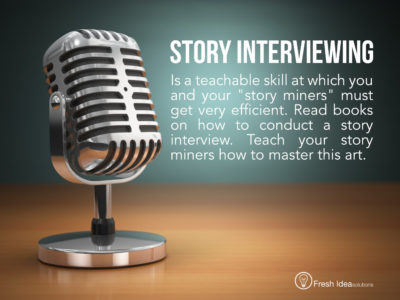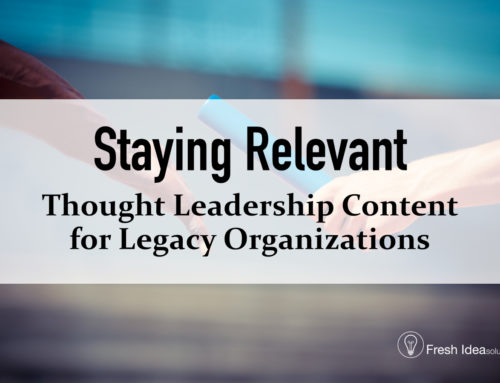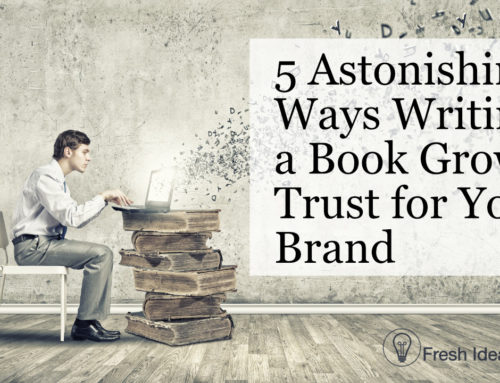Gold doesn’t uncover itself. Diamonds don’t fall from the sky. And stories don’t tell themselves. Here are seven components you’ll need for your story mining system that will find, capture, and publish stories for your nonprofit or higher education marketing.
It was a balmy day in early June when I walked into the team meeting in my new office in Dallas, Texas.
I was the new alumni director for my alma mater, and in front of me were three students who were assigned to my office for their work scholarship.
As far as alumni marketing goes, our task was typical: Reconnect alumni to the school’s brand and engage them in promoting the school to prospective students in their circles of influence.
The students had one question: How in the world are we going to do that?
“We’re going to tell stories.”
Six weeks later, my little office of interns was cranking out 1,000-word stories once a week and distributing that content through our digital marketing channels.
On our blog, social media channels, and personal conversations, we told the personal stories of our alumni and current students.
We told stories about the good work they were doing in the world. We told stories of how they came to our school and how their lives had changed because of it.
These intensely personal stories heralded everything our education brand stood for.
And it worked.
Soon, our alumni Facebook page was catching up in likes and shares with the school’s main page. Our stories were drawing so much traffic, we became a traffic source for the school’s home page and enrollment landing pages.
Nonprofits, colleges, and universities have stories just like this happening all around them—and they don’t even know about it!
Story Mining
To make brand storytelling work for your education brand, you have to create a story capturing method or as I called it, a story mining system.
You need a systemized method for identifying, capturing, writing, and publishing good stories consistently.
Story Mining: A system for finding, capturing, writing, and publishing great stories consistently for your #contentmarketing. #branding #highered #marketing #nonprofit Click To TweetThis is how education and nonprofit brands are built. One story at a time.
Here are the components to the story mining workflow I used to engage my alumni audience every week with powerful education brand stories.
1. Recruit story miners.
It’s not enough to tell everyone in your organization to send in story recommendations. And it’s not enough to have an alumnus story sharing tool on your website.
Especially if you’re getting started in brand storytelling, you need to recruit story miners whose clear assignment is to dig up good stories.
Look around you and see who can be your story miners. Good story miners are people who care about your cause and love to hear a good story.
- Volunteers
- Interns
- Staff members
- Alumni
- Donors
- Students
2. Teach them story elements.
Your story miners don’t have to be epic storytellers like James Cameron, but they do need to know the basics of a good story.
If your story miners are story geeks, give them the classic story elements of the hero’s journey:
- Hero
- Stakes
- Antagonist
- Mentor
- Inciting Incident (also called “Call to Adventure”)
- Denial (or “Refusing the Call”)
- Trials
- Inner Struggle
- Victories
- Resolution (or the moral of the story or how the hero has changed)
But if these concepts are too esoteric, use the nitty-gritty journalistic approach:
Who? What? When? Where? How?
3. Create a shared editorial calendar.
You may not know which stories will surface nor when they’ll be available for publishing, but you must have a shared editorial calendar where your story miners and writers update their progress on various stories.
(Want to create winning editorial calendars with less hassle? Download the free guide below!)
This is the accountability tool that keeps the whole team on task and moving towards the goal.
Your editorial calendar is the antidote to confusion, which will lead to the death of your nonprofit marketing strategy.
4. Set weekly story mining goals.
How many stories will you publish each month? Per week?
How many people do you need to interview to make that goal happen? How many interview requests have to be made by email or phone to schedule enough interviews to publish that many stories per week?
Break down the process of mining your stories into simple steps and assign goals to each step to discover, capture, and publish more stories for your #contentmarketing and #brandstorytelling strategy. #highered #nonprofit Click To TweetAs an alumni director, I knew that it took an average of 3 weeks to mine and publish a good story. I knew that out of every 5 requests, we’d get 1 interview scheduled within the month.
So those became our story mining goals.
- Goal 1: 5 interview requests per week.
- Goal 2: Conduct 1 interview per week.
- Goal 3: Publish 1 story per week
5. Go to events and network.
My story miners and I would go to various functions, team meetings, and events throughout our organization to introduce ourselves and talk to people about their experiences.
We spoke to them about the one thing everyone loves to talk about—themselves!
After hearing a 5-minute story from someone at an alumni reunion, I would ask them if we could set up a more in-depth interview with them. They almost always said yes!
 6. Master the art of interviewing.
6. Master the art of interviewing.
Interviewing is a teachable skill. Read books on how to conduct a story interview. Teach your story miners how to master this art. Get your interviews down to 30 minutes or so, if you can.
7. Make story mining a priority in your office calendar.
Often, one of my story miners would tell me that they couldn’t make it to one of my staff meetings because they were scheduled for a call with a story subject.
Other times, they would have to use my office to conduct in-person interviews, so I gave them my private office while I worked with the interns in a shared office space.
We did whatever it took to mine the stories and get them out. It was our top priority.
8. Create a clear story permission policy.
We made sure that every person we interviewed gave us clear permission to use their story in whatever format we used.
We would send them our drafts or videos for approval before we published them. We would mark down when and who gave us publishing permission.
Don’t take it for granted that your story subjects are happy with the way you handled your story.
Sometimes we had to cancel a story because our story subject changed their mind and would not give final permission for us to publish the piece. Protect your education brand. Don’t publish a story that your story subject does not approve of.
9. Systematize content distribution.
After the story was written and final permission granted, we created a step-by-step distribution process for the story miners to follow.
Each post needed original photography of the story subject. Each post was to be published on our department’s various social media platforms. Each post was to be shared throughout the various marketing channels the school at large was using.
It was a checklist that made sure that our content was getting out to our audience every single time.
10. Leverage your story subject’s audience.
Part of our distribution plan was to piggy-back off of our story subject’s network.
Many of our story subjects were influencers with their audience. Some were regular folk who had friends and family reading their posts.
Either way, when they shared the story we wrote about them with their audiences, we’d get a big spike in web traffic and comments on the piece from their networks.
Do your best to have your story subjects share the story you wrote about them with their audience. Provide them with the links, images, or any other component necessary for them to share the content you made.
It’s worth the effort.
The secret to arresting the attention of your audience, engaging them in the mission, and motivating them to action is no secret: Tell good stories. But more than that, you’ve got to…
Tell good stories consistently.
Hands down, consistently is the hard part of the whole thing—and that’s why you need a story mining method to find, capture, and publish great stories for your nonprofit or education brand.







Great advice. Although I’m in a different type of market, there are certainly some nuggets that I can use in my own content creation/marketing. Specifically using a content calendar. Working for myself, at least having some nominal accountability to a calendar will be helpful. I’ll save this post and see how many of those bullet points I can put to work for me. Thanks!
Absolutely, Dwayne! Story mining is necessary for anyone looking to attract and cultivate new customers. At the very least, you’ve got to mine for testimonials or quotes to showcase your work. All the best!